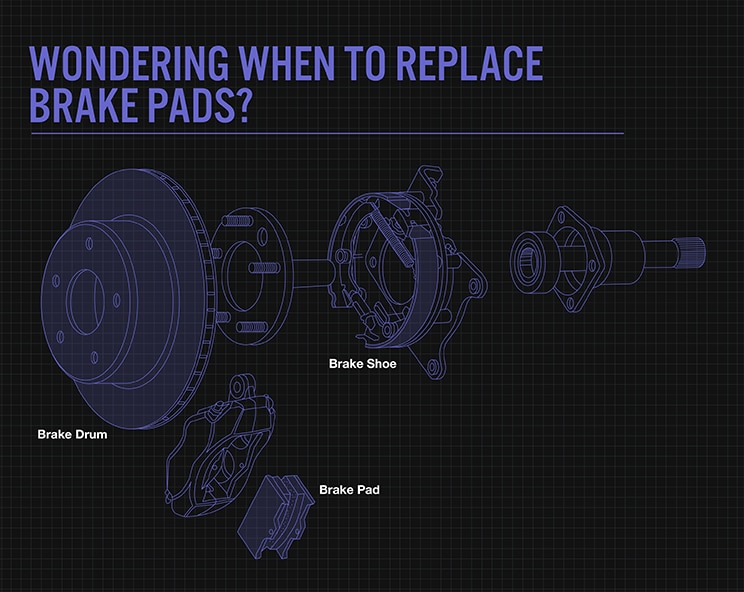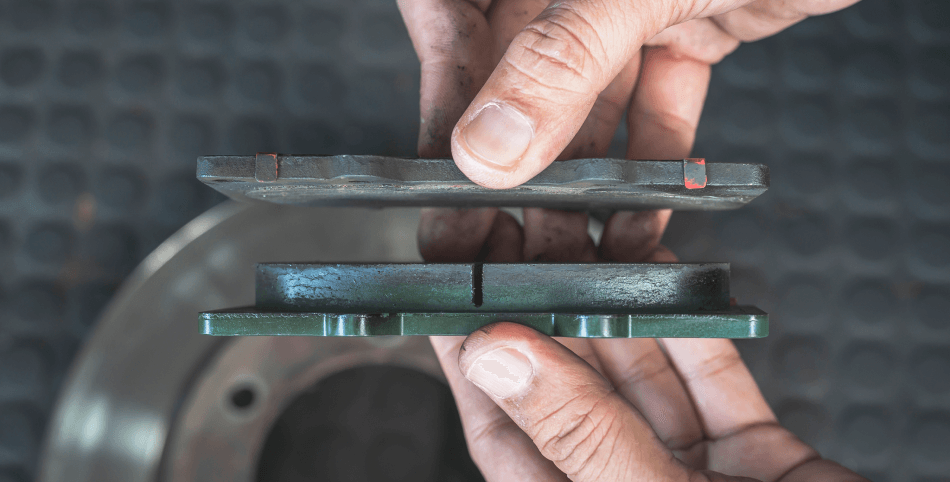You should replace brake pads when the thickness is 3mm or less to ensure safe braking. It is essential to monitor the brake pad thickness regularly to maintain optimal braking performance and safety on the road.
Brake pads are a crucial component of your vehicle’s braking system, playing a vital role in ensuring your safety on the road. Knowing when to replace brake pads is essential to maintaining optimal braking performance and preventing potential accidents.
This blog post will explore the signs that indicate it’s time to replace your brake pads, factors affecting their lifespan, and tips for maintaining your braking system.

Credit: www.bridgestonetire.com
Contents
- 1 Brake Pads and Their Function
- 2 When to Replace Brake Pads
- 3 How to Check and Replace Brake Pads
- 4 Maintenance Tips to Extend Brake Pad Life
- 5 Frequently Asked Questions
- 6 Conclusion
Brake Pads and Their Function
Brake pads are part of a disc brake system, which is common in most modern vehicles. When you press the brake pedal, hydraulic fluid forces the brake calipers to squeeze the brake pads against the rotating brake rotors. This friction slows down and eventually stops the vehicle. Over time, this friction causes the brake pads to wear down, reducing their effectiveness.
The material used in brake pads varies, including organic, semi-metallic, and ceramic compounds. Each type has different properties, affecting wear rate, braking performance, and noise levels.
How Long Do Brake Pads Last?
The lifespan of brake pads can vary significantly depending on various factors, including driving habits, road conditions, the type of brake pads, and the vehicle’s make and model. On average, brake pads last between 30,000 to 70,000 miles. However, some high-performance or heavy-duty brake pads may last longer, while others may wear out sooner.
Factors Affecting Brake Pad Lifespan:
- Driving Habits:
- Aggressive Driving: Frequent hard braking, sudden stops, and driving at high speeds can accelerate brake pad wear.
- City vs. Highway Driving: City driving with frequent stops and starts tends to wear out brake pads faster than highway driving, where braking is less frequent.
- Road Conditions:
- Hilly Terrain: Driving in mountainous or hilly areas requires more braking, leading to quicker wear of brake pads.
- Stop-and-Go Traffic: Constant stopping in heavy traffic can reduce the lifespan of brake pads.
- Brake Pad Material:
- Organic Pads: Made from materials like rubber, glass, and resins, organic pads are softer and quieter but wear out faster.
- Semi-Metallic Pads: These are more durable and offer better performance, especially in high-temperature conditions, but can be noisier and wear down the rotors faster.
- Ceramic Pads: Known for their longevity, ceramic pads are quiet and produce less dust, but they are usually more expensive.
- Vehicle Type and Weight:
- Heavier vehicles, such as trucks and SUVs, put more stress on brake pads, causing them to wear out more quickly.
When to Replace Brake Pads
Knowing when to replace brake pads can prevent costly damage to your braking system and ensure your safety. Here are some common signs that indicate it’s time for a replacement:
1. Squeaking or Squealing Noise
One of the most common signs of worn brake pads is a high-pitched squealing noise when applying the brakes. This noise is usually caused by a small metal shim, known as a wear indicator, that becomes exposed as the brake pads wear down.
2. Grinding Sound
If you hear a grinding or growling noise, it likely means the brake pads are completely worn out, and the metal backing plate is making contact with the brake rotor. This can cause significant damage to the rotors and should be addressed immediately.
3. Vibration When Braking
If you feel a vibration or pulsation in the brake pedal when braking, it may indicate that the brake pads are unevenly worn or that the rotors are warped. This issue requires prompt attention to prevent further damage.
4. Longer Stopping Distances
If you notice that your vehicle takes longer to stop than usual, it could be a sign that the brake pads are worn and no longer providing adequate friction. This can be particularly dangerous in emergency situations.
5. Brake Pad Thickness
Visually inspecting the thickness of your brake pads can give you an idea of their condition. If the pads are less than a quarter-inch thick, it’s time to consider replacing them.
6. Brake Warning Light
Some modern vehicles are equipped with a brake warning light that illuminates when the brake pads are nearing the end of their lifespan. This is a clear indication that it’s time for a replacement.
7. Pulling to One Side
If your vehicle pulls to one side when braking, it could be due to uneven wear of the brake pads or a problem with the brake calipers. This issue should be inspected by a professional.
Consequences of Not Replacing Worn Brake Pads
Neglecting to replace worn brake pads can lead to several serious consequences, including:
1. Damage to Rotors
Worn brake pads can cause the metal backing plate to grind against the brake rotors, leading to grooves, scoring, and warping. This damage may require costly rotor replacement.
2. Decreased Braking Efficiency
As brake pads wear down, they lose their ability to generate sufficient friction, leading to longer stopping distances and reduced braking power.
3. Increased Risk of Accidents
Ineffective braking can increase the likelihood of accidents, especially in emergency situations where quick stopping is crucial.
4. Costly Repairs
Ignoring worn brake pads can lead to more extensive damage to the braking system, resulting in expensive repairs or even the need for a complete brake overhaul.
How to Check and Replace Brake Pads
While it’s advisable to have your brake pads inspected and replaced by a professional, you can also perform a basic check at home. Here’s how:
1. Visual Inspection
Safely jack up your vehicle and remove the wheel to inspect the brake pads. Look for signs of wear, such as thinning pads or uneven wear patterns.
2. Listen for Noises
Pay attention to any unusual noises when braking, as they can indicate worn pads or other issues in the braking system.
3. Monitor Brake Performance
If you notice any changes in braking performance, such as longer stopping distances or a soft brake pedal, have your brakes checked immediately.
4. Replacement Process
If you decide to replace the brake pads yourself, follow these steps:
- Loosen the lug nuts and jack up the vehicle.
- Remove the wheel and locate the brake caliper.
- Remove the caliper bolts and carefully lift the caliper off the rotor.
- Remove the old brake pads and replace them with new ones.
- Reassemble the caliper and wheel, then lower the vehicle.
- Test the brakes to ensure they are functioning correctly.

Credit: www.trodo.com
Maintenance Tips to Extend Brake Pad Life
Proper maintenance can help extend the life of your brake pads and ensure optimal braking performance:
- Drive Smoothly: Avoid aggressive driving, sudden stops, and high-speed braking to reduce wear on your brake pads.
- Downshift on Hills: When driving downhill, use lower gears to reduce the need for constant braking.
- Regular Inspections: Have your brake system inspected regularly by a professional to catch any issues early.
- Use Quality Brake Pads: Invest in high-quality brake pads that are suited to your driving needs and vehicle specifications.
- Keep the Braking System Clean: Ensure that the brake components, including rotors and calipers, are clean and free of debris.
Frequently Asked Questions
Here are some FAQs about the replacing brake pads –
How Do You Know When Brake Pads Need Replacing?
Brake pads need replacing when you notice signs like squeaking or grinding noises, reduced braking performance, longer stopping distances, or a pulsating brake pedal. Inspecting the thickness of the brake pads regularly can also help determine if they are worn and need replacement.
How Long Will A 3mm Of Brake Pad Last?
A 3mm brake pad typically lasts around 50,000 miles, but this can vary based on driving habits and conditions.
Should I Replace Brakes At 4mm?
Yes, it’s advisable to replace brakes at 4mm to maintain optimal safety and performance levels.
Do I Need New Rotors Or Just Brake Pads?
To determine if you need new rotors or just brake pads, it’s best to consult with a professional mechanic. They will inspect your vehicle and assess the condition of both the rotors and brake pads. This will ensure you receive the appropriate repairs for optimal braking performance.
Why Is It Important To Replace Brake Pads?
Replacing brake pads ensures safe and efficient braking performance, preventing accidents and damage to the vehicle.
Conclusion
To sum up, replacing brake pads is a crucial aspect of vehicle maintenance. Failing to replace them in a timely manner can result in serious accidents and costly repairs. Knowing when to replace your brake pads can save you money and ensure your safety on the road.
By regularly inspecting your brake pads and listening for warning signs, you can stay ahead of any potential issues. Remember, it’s always better to be safe than sorry when it comes to your brakes.